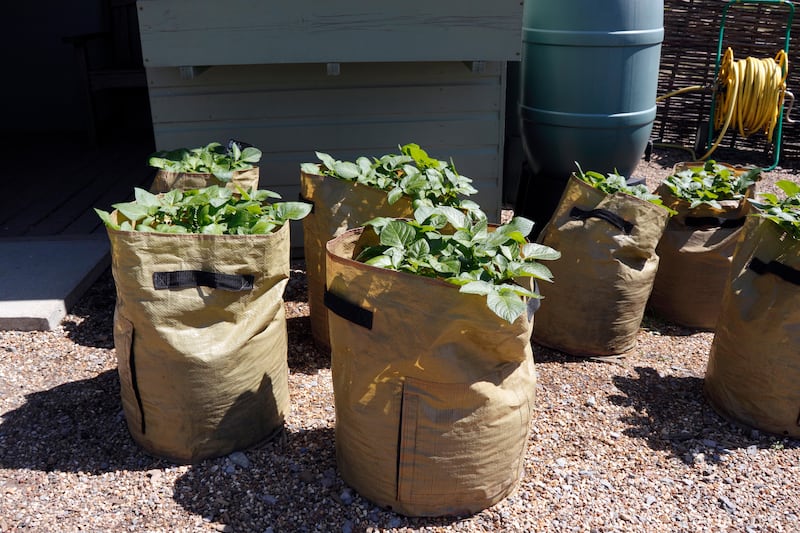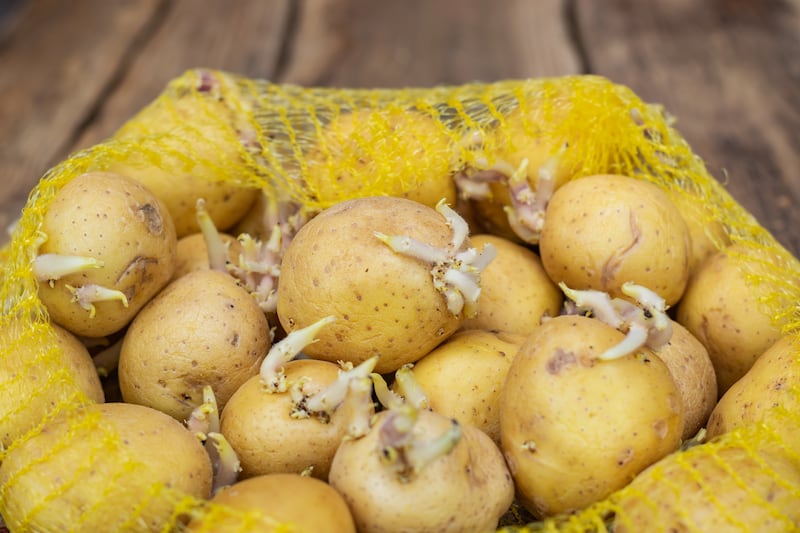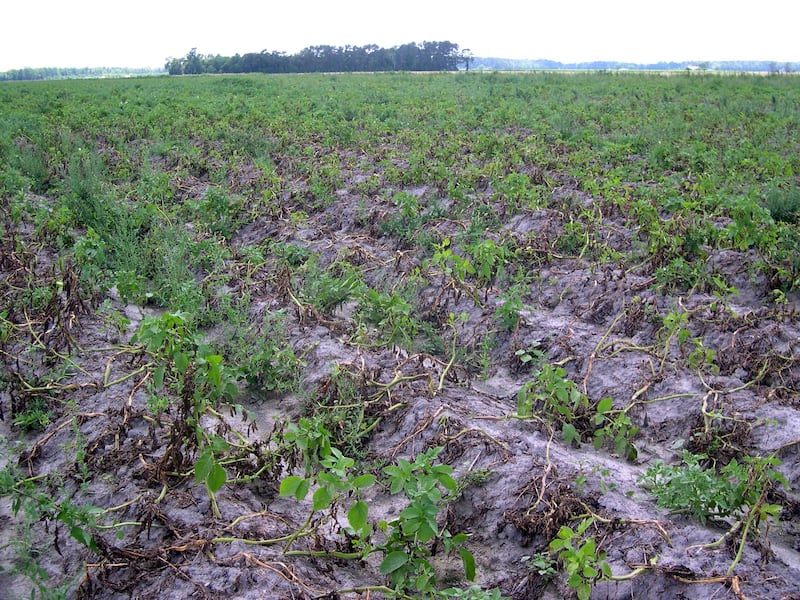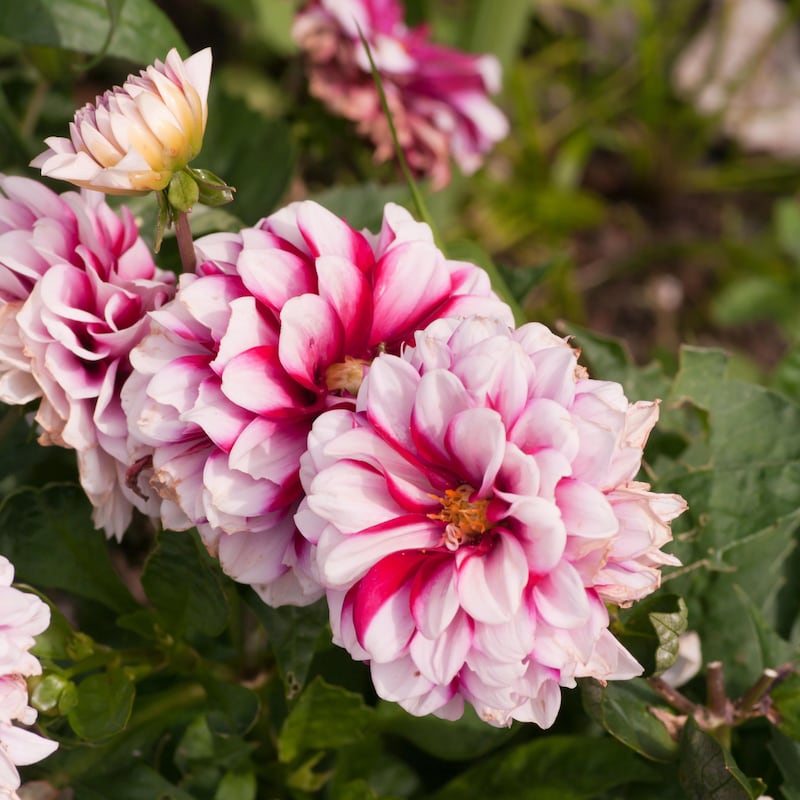They say that you can tell a surprising amount about a gardener by the kind of potatoes they grow. Some of us, for example, are traditionalists who’ll plump for the floury, fluffy ‘British Queen’ (colloquially known as ‘Queens’) every time. Others are passionate foodies who prefer the firm, waxy, flavoursome, yellow flesh of a salad potato such as ‘Charlotte’, or the heirloom ‘La Ratte’. Individualists, meanwhile, often like to seek out unusual kinds, such as the dark magenta-fleshed ‘Vitanoire’, or the knobbly ‘Pink Fir Apple’, the heritage variety famed for its more-ishness.
But as another season of potato planting kicks off later this month, it’s important to bear in mind that colour, taste, texture and good looks aren’t everything when it comes to choosing the perfect variety to grow in your garden or allotment. Instead, it ideally also needs to be vigorous and productive, as well as resistant to a range of pests and diseases. The number of weeks that it takes from planting to harvest is yet another important consideration. First-earlies and second-earlies, for example, are faster growing and much quicker to crop, meaning they’re less likely to succumb to blight. But the downside is that these early varieties are also typically much less suitable for storage.
Unfortunately, good disease resistance is not something that can be said of our most popular heritage varieties, such as the aforementioned ‘British Queen’ and ‘Pink Fir Apple’, as well as ‘Kerr’s Pink’, ‘Arran Pilot’, ‘Maris Piper’ and Sharpe’s Express’, all of which are now known for their vulnerability to potato blight.
This vulnerability makes them a particularly poor choice for organic gardeners who want to avoid the use of environmentally harmful fungicides. For those growing potatoes in densely planted community gardens or allotments, where there’s likely to be numerous different crops growing in close proximity, the risk of disease is even greater. Add to that the growing challenge of climate change in the shape of summer downpours that create exactly the kind of wet, humid growing conditions in which blight quickly spreads and slugs thrive.
READ MORE
To top it all off, scientific monitoring of the pathogen Phytophthora infestans which causes blight confirms that it’s constantly evolving, with new vigorous strains emerging that are increasingly resistant to the fungicidal sprays traditionally used to control it. These new strains also pose an increasing threat to many popular contemporary varieties up until recently regarded as having quite good blight resistance.

Faced with such a complex combination of challenges, more and more Irish gardeners are unsurprisingly abandoning these much-loved cultivars in favour of new varieties bred specifically for the desirable traits discussed above. Examples include the aforementioned ‘Vitanoire’, one of whose parents is the outstanding variety known as ‘Vitabella’, an early variety prized for its firm waxy flesh and high blight resistance. Others include ‘Agostino’ (a red-skinned maincrop variety with excellent disease resistance); ‘Allouette’ (an early maincrop variety with outstanding blight resistance); ‘Axona’ (a very vigorous, easy-to-grow, disease-resistant, red-skinned maincrop variety); ‘Connect’ (a very productive and versatile maincrop variety with outstanding disease resistance); ‘Nola’ ( a high-yielding maincrop variety with excellent disease resistance that also stores very well); and ‘Sevilla’ (a vigorous maincrop variety with great blight resistance and a tolerance of poorer soils).
Always make sure to source good-quality, certified seed-potatoes from a reliable supplier
But while the emergence of this new generation of versatile, tasty, vigorous, disease-resistant varieties of potatoes is great news for gardeners, what does it mean for heritage varieties, which represent such an important part of our rich horticultural past? Sadly, it’s likely that many will slowly but surely go the way of the ‘Lumper’, the famine-era variety forever infamous for its susceptibility to blight. Once widely cultivated in Ireland, it’s now only grown either as an historical curiosity or as part of significant potato collections carefully conserved by Government-funded bodies such as the Tops potato propagation centre in Raphoe, Co Donegal.

The Tops collection numbers more than 400 varieties that were in cultivation in Ireland from before 1800 right up until 1950. It includes pink, blue-black and red-skinned potatoes, some with colourful flesh, and many with deep “eyes” and uneven, irregular tuber shapes that look strange to contemporary gardeners accustomed to the smooth-skinned, neat oval and near-spheres of modern varieties bred for ease of peeling.

Some of their varietal names – ‘Blight Destroyer’, ‘Peerless’, ‘Champion’ – are also a poignant reminder of a time when their now much-dwindled resistance to blight was powerful enough to earn them such monikers. Many are rarities that were once particular to only certain regions of the country. Their cultivation is reflective of an agricultural past that stretches right back to the late 1600s, where most potato varieties arose as rogue varieties from seed rather than as a result of deliberate breeding programmes.
[ An expert’s guide to the best places to buy seeds and bulbsOpens in new window ]
It’s worth noting that their careful conservation isn’t just for reasons of sentimentality, but more a recognition of these potato varieties’ scientific importance as a treasure trove of genetic diversity that could potentially prove very valuable in future breeding programmes. If you’d like to discover more about some of them, then head along to one of the Potato Days being held around the country in the coming weeks, including that being held tomorrow at the Organic Centre in Co Leitrim. The centre also stocks a wide range of certified seed potatoes at this time of year, including many of the new disease-resistant varieties mentioned above (organiccentre.ie).
If you’re one of the many gardeners who plans on growing any of the more traditional varieties this year, then bear in mind that there are other ways to help prevent your plants from succumbing to disease this summer. To begin with, always make sure to source good-quality, certified seed-potatoes from a reliable supplier. As mentioned above, also bear in mind that early varieties are less vulnerable to attack. Choose the site carefully (always avoid planting into poorly drained ground), prepare it well (potatoes like a rich, deep, free-draining, friable soil enriched with plenty of well-rotted manure) and be very mindful of crop rotation. Potato ‘dumps’ left on the ground from last summer or ‘volunteers’ hiding in the soil can potentially act as a source of disease, so remove these before planting and bin them. Planting at extra generous spacings will also help to discourage blight by discouraging growing conditions favourable to the disease from developing.
Invest in a good waterproof garden notebook to keep careful notes throughout the coming growing season
Finally, watch out for early signs of blight (dark-brown patches surrounded by a pale “halo”, visible on wilting foliage and stems) and pay close attention to blight warnings (see met.ie). If it does hit your crop, then quickly cut the plant stems back to ground level to avoid the disease penetrating to the tubers, before quickly bagging and binning the stems.
This week in the garden
Dahlia tubers can be potted on under cover of a glasshouse, polytunnel, conservatory or bright porch this month to give earlier-flowering plants that can be planted out into the garden in late May/early June. Use a good quality multipurpose compost to do this, and make sure to avoid overwatering – as the fleshy tubers can be prone to rotting in damp compost in the weeks before they develop new vigorous root systems.

The crazy rush of early spring is about to begin, so try to finalise seed and bulbs orders, drop garden machinery in for its annual service, clean and sharpen tools and wash down seed trays and growing structures in preparation. Also invest in a good waterproof garden notebook to keep careful notes throughout the coming growing season. From varietal names, useful suppliers and sowing/germination/flowering times, to reminders on border gaps to fill and plants to move, it will serve as an invaluable record.

Dates for your diary
Tomorrow, Sunday March 3rd, 12-4pm, Potato Day at the Organic Centre, Rossinver, Co Leitrim, with a very wide range of seed potatoes for sale, plus garden tours, potato talks and demonstrations, see theorganiccentre.ie
Wednesday, March 6th (8pm), Howth Yacht Club, From Blank Canvas to Colourful Borders, a talk by Mary Keenan of Gash Gardens, Co Laois, on behalf of Howth and Sutton Horticultural Society, see hshs.ie
Friday, March 15th, Ballymaloe Cookery School, Shanagarry, Co Cork, How to Grow and Arrange Your Own Cut-Flowers Seasonally and Sustainably, a one-day hands-on workshop with organic gardener, flower farmer-florist and Irish Times gardening columnist Fionnuala Fallon, see ballymaloecookeryschool.ie
Saturday 23rd March, Dunmore Cookery School, Durrow, Co Laois, How to Grow Your Own Food Sustainably, a one-day hands-on course with organic gardener and writer Tanguy de Toulgoët, see dunmorecountryschool.ie
- See our new project Common Ground, Evolving Islands: Ireland & Britain
- Sign up for push alerts and have the best news, analysis and comment delivered directly to your phone
- Find The Irish Times on WhatsApp and stay up to date
- Our In The News podcast is now published daily – Find the latest episode here















